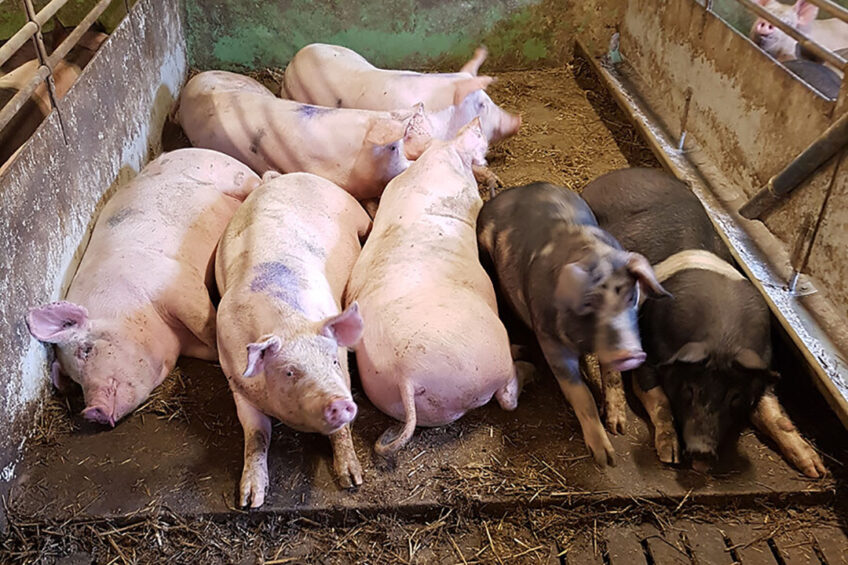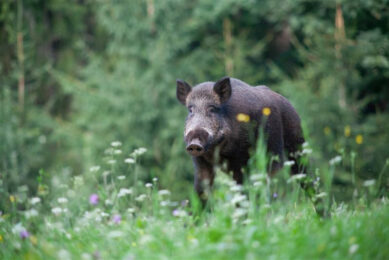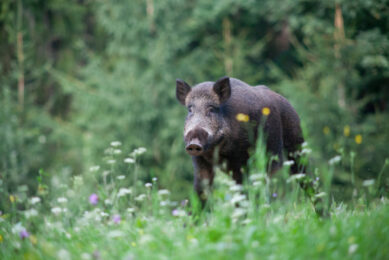Cooling down for more hygiene, less ammonia

Keeping pigs cool in times of heat stress has a positive effect on their fouling behaviour and subsequently on the formation of ammonia. In Sweden, researchers tested 2 methods of cooling finisher pig houses with partly slatted floors and measured the effect on fouling behaviour.
Partly slatted pens have a solid floor for pigs to lie on and a permeable slatted floor as a dunging area for the pigs. This design enables allocation of some litter as enrichment. Use of litter reduces problems with tail biting when rearing undocked growing/finishing pigs and is considered to improve pig welfare.
Pigs also prefer a solid lying area with litter under thermoneutral environmental conditions. If the solid pen area is kept clean, pig houses with a partly slatted floor system in the pens have around 25% lower NH3 emissions than houses with a fully slatted floor system. That is explained by the smaller emitting surface area.
Pen fouling
However, during summer periods with high ambient temperatures, pen fouling can occur. Pen fouling leads to impaired hygiene and air quality, increased NH3 emissions and extra work trying to keep the pen clean. Pen fouling problems have increased in Sweden in recent decades. Suggested explanations are that modern pig genotypes are more sensitive to climate change–related heat stress and prolonged periods with high ambient temperatures inside pig buildings during summer months. Measures to reduce the problem are needed. Two possible methods for cooling pigs in existing buildings, tested within the research project PigSys, are described in this article.
Pen fouling may depend on many factors. In hot conditions, the main causes are unfavourable thermal climate for the pigs, in combination with restricted space allowance. To cope with this situation the pigs change their lying posture, increasingly lie on the slatted floor since it is the coolest place in the pen, excrete on the solid floor and start to wallow.
Pig cooling measures
2 different measures for cooling housed pigs during very warm summer weather (2018 and 2019) were tested in the study. These were:
- Showering above the slatted area; and
- Increasing the air velocity on the lying area by readjusting the ceiling inlets (from 35 to 75 degrees relative to the ceiling).
The study was performed in one grow-finishing pig house on an integrated commercial pig farm in southern Sweden with 480 sows and 3,600 growing-finishing places. The grow-finishing pig house had ten identical rooms, with 16 partly slatted pens in each. Each pen could accommodate nine to 13 finishing pigs and had a floor that was 70% solid concrete and 30% concrete slats. In different batches, showering or readjusted ceiling inlet treatment was compared with an untreated control.
In the shower treatment, the slatted area in each pen was showered with water controlled by the ventilation system. Showering started when the air temperature in the compartment exceeded the target temperature by more than 0.5°C.
In the treatment with readjusted ceiling inlets, the maximum air velocity on the lying area was increased from about 0.5 m/s to 1.0 m/s when the temperature of the inlet air exceeded a certain limit value. Readjusting the ceiling inlets changed both the air flow pattern and the air velocity at maximum ventilation in different areas of the pens. With the larger opening angle, the inlet air was aimed directly down into the animal lying area, increasing air velocity in this area.

Shower treatment
In the control rooms, with no cooling, the pigs had started to lie on the slatted floor already in week 6 of the batch, weighing about 40kg, and the percentage lying on the slatted area increased throughout the batch. In comparison with control pigs, the pigs in the shower treatment used the lying area more, and the slatted area much less, when lying. No difference in pig activity was seen between the treatments. Pen fouling scoring revealed that fouling increased throughout the measuring periods in both the shower and control rooms, but that overall pen fouling was significantly less in the shower treatment than in the control.
Average ammonia concentration in outlet air varied in the range 3.2–8.7 ppm and 4.4–10.8 ppm in the shower treatment and control, respectively.
Consequently, mean ammonia emissions were lower in the shower treatment (3.0–5.1g pig-1 day-1) than in the control (4.2–10.0g pig-1 day-1), with greater differences between the treatments at the end of the growing period. The differences were significant in all four measuring periods during the batch. The shower system reduced ammonia emissions during summer by 45%.
Increased air velocity
In the experiment with altered air velocity in the lying area, the treatment with readjusted air inlets and maximum 1.0 m/s showed a positive effect compared with the control. However, the difference obtained was not as large as that between shower treatment and control. The pigs were observed lying significantly more in the area with increased air velocity and less on the slatted floor. Pen fouling was significantly reduced.
Measured ammonia concentration in outlet air varied in the range 3.7–11.0 ppm and 3.9–14.4 ppm in the readjusted air inlet treatment and control, respectively. Mean ammonia emissions during the measuring periods increased from 3.4g to 6.6g pig-1 day-1 in the treatment with readjusted air inlets and from 3.3g to 8.4g pig-1 day-1 in the control. A significant reduction in emissions in the readjusted air inlet treatment was found, but only in late stages of the batches. During the late period of the batches the ammonia emissions were reduced by 21%. For an entire batch, increased air velocity on the lying area reduced ammonia emissions during summer by 13%.
Future developments
One disadvantage with the shower technique is of course the water consumption, which increased by 20–35%. However, the settings and control of the shower system can be improved. The PigSys project has provided the tools needed for refinement of the technique controlling pig behaviour and house environment, using a decision support system (DSS), computer vision and various sensors.
Cooling the pigs with forced convection during periods with high ambient temperatures is a well-known method used in pig houses. However, the potential for using higher air velocity in pig houses as a measure to cool the pigs has not yet been fully utilised. In future work, cooling/heating of the lying area may be tested, as well as the possible addition of various odours and light to guide the pigs to suitable behaviour in the housing system.
Authors:
Knut-Håkan Jeppsson, Anne-Charlotte Olsson and Abozar Nasirahmadi
Jeppsson and Olsson are attached to the Swedish University of Agricultural Sciences (SLU) and Nasirahmadi to the University of Kassel, Germany. This research was part of the EU project PigSys; the website www.pigsys.eu shares more details about the set-up of the investigation.











